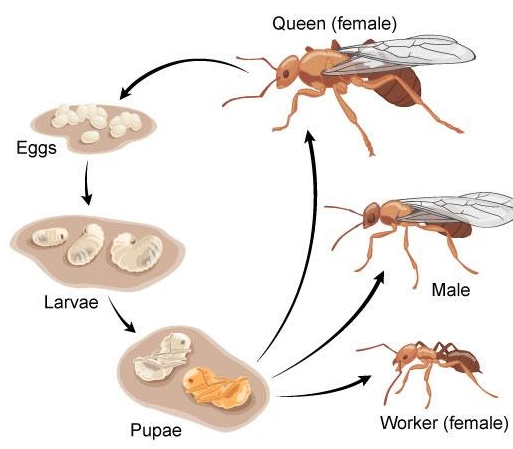
In which stage of complete metamorphosis, does a creature eat a lot in order to store food?
A) Egg
B) Larva
C) Adult
D) Both B and C
Answer
431.7k+ views
1 likes
Hint: Metamorphosis is the series of changes an organism undergoes to convert itself from egg to an adult. In case of complete metamorphosis, there are four stages of development- egg, larva, pupa and adult stage. All these stages vary in terms of morphology. Example- ant, moths, wasps, butterflies etc.
Complete answer:
Metamorphosis is a series of gradual changes which an organism undergoes after the birth to become an adult. The change includes several cell differentiation and division. This cycle is controlled by the hormone thyroxine secreted thyroid glands. In case of complete metamorphosis, the growth and differentiation take place in four steps.
Let us discuss the complete metamorphosis in insects.
Egg- The first step of complete metamorphosis starts from the egg. The insects hatch from the egg and mature into a larva.
Larva- The larva is the small worm which feeds continuously so that they can grow and also store food for further developmental stages.
Pupa- At the end of the larval stage the insects will make hard shell-like outer covering and develop as pupa. At this stage they do not eat or move but undergo several developmental processes.
Adult- The pupa breaks the hard shell and emerges as an adult moth after complete development. The exoskeleton is completely developed and is ready for the reproductive phase.

Therefore the correct answer is option ‘B’.
Note: Another type of metamorphosis is the incomplete metamorphosis where the egg hatches to a nymphal stage which develops into an adult. The nymph resembles the adults but are smaller in size and the wings are absent. Example- cockroach, grasshoppers.
Complete answer:
Metamorphosis is a series of gradual changes which an organism undergoes after the birth to become an adult. The change includes several cell differentiation and division. This cycle is controlled by the hormone thyroxine secreted thyroid glands. In case of complete metamorphosis, the growth and differentiation take place in four steps.
Let us discuss the complete metamorphosis in insects.
Egg- The first step of complete metamorphosis starts from the egg. The insects hatch from the egg and mature into a larva.
Larva- The larva is the small worm which feeds continuously so that they can grow and also store food for further developmental stages.
Pupa- At the end of the larval stage the insects will make hard shell-like outer covering and develop as pupa. At this stage they do not eat or move but undergo several developmental processes.
Adult- The pupa breaks the hard shell and emerges as an adult moth after complete development. The exoskeleton is completely developed and is ready for the reproductive phase.

Therefore the correct answer is option ‘B’.
Note: Another type of metamorphosis is the incomplete metamorphosis where the egg hatches to a nymphal stage which develops into an adult. The nymph resembles the adults but are smaller in size and the wings are absent. Example- cockroach, grasshoppers.
Latest Vedantu courses for you
Grade 11 Science PCM | CBSE | SCHOOL | English
CBSE (2025-26)
School Full course for CBSE students
₹41,848 per year
Recently Updated Pages
Master Class 12 Economics: Engaging Questions & Answers for Success

Master Class 12 Maths: Engaging Questions & Answers for Success

Master Class 12 Biology: Engaging Questions & Answers for Success

Master Class 12 Physics: Engaging Questions & Answers for Success

Master Class 12 Business Studies: Engaging Questions & Answers for Success

Master Class 12 English: Engaging Questions & Answers for Success

Trending doubts
What is the Full Form of PVC, PET, HDPE, LDPE, PP and PS ?

What are saprophytes Give two examples class 12 biology CBSE

How do you convert from joules to electron volts class 12 physics CBSE

Mirage is a phenomena due to A Refraction of light class 12 physics CBSE

Why did French artist Frederic sorrieu prepare a series class 12 social science CBSE

What is Nutrition Explain Diff Type of Nutrition ?




